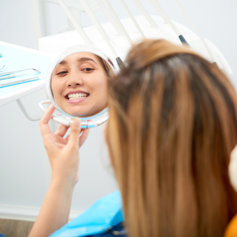Dentists Can Curb Opioid Addiction and Still Help Patients with Post-Operation Pain

New research shows that dental operations and surgeries that would legitimately require opioids in the post-op phase are extremely rare. However, many dental practices are still writing prescriptions for opioids when OTC pain relievers would likely suffice.
One of the main concerns among dentists has been the potentially harmful effects on patients if dentists stop prescribing opioids. However, researchers provided compelling evidence that such effects likely won’t occur. The researchers followed a group of New York dentists that moved away from prescribing opioids and instead shifted to only utilizing OTC medications for pain relief.
The result? No harmful effects among patients. Patients prescribed non-opioid OTC pain relievers instead of opioids could sufficiently manage their post-operation pain.
To reduce addiction risk and to follow CDC recommendations on curbing opioid prescribing, dentists should cease prescribing opioid pain relievers and instead recommend non-opioid OTC pain relief options for their patients.
New Research Shows No Harmful Effects with a Non-Opioid Approach to Dental Pain
Many opioid addicts can trace the beginning of their addiction to a time when they were given a legitimate prescription for opioid pain relievers to treat short-term pain, as in the case of a dental operation. Because of that, a concerted campaign has evolved around efforts to significantly reduce opioid prescribing in America, especially in fields where opioid interventions are unnecessary.
Dentists recently published new developments in the form of a JAMA Network Open research paper detailing the effects of eliminating opioids from dental prescribing. According to the project’s team lead, Dr. Yanfang Ren, dental practitioners were thrilled to move completely away from opioids and to be able to find other ways to treat patient pain with almost zero negative effects.

Not only did the patients involved in the study experience pain relief, but the non-opioid painkillers were reported to have worked better than the opioid painkillers. According to the researchers, 21% of patients who had previously been treated with opioids experienced harmful effects. However, after the dentists shifted away from opioids and began to treat patients with solely gabapentin, ibuprofen, and acetaminophen, only 2.2% reported negative outcomes.
In celebrating the success of the project and what it meant for reducing the risk of opioid addiction among patients, Dr. Ren had this to say about the practice’s new approach, “Considering that 1,800 patients received more than 20,000 opioid pills annually in our clinic before implementation of the opioid reduction strategy, eliminating opioid prescriptions may mean that approximately 105 individuals annually will not develop new and persistent opioid use associated with treatment at our clinic.” Looking to the future, it may behoove other dental practices to model their opioid policy after the New York clinic, as it seems not only are OTC pain relievers less risky than opioids, but they’re also more effective.
The U.S. Is Still Far Out of Step with Other Western Nations in Dental Opioid Prescribing
Hopefully, the approach taken by the dentists at the University of Rochester Medical Center is a bellwether for the future of dental practice in the United States. Currently, the U.S. is still far out of step with other western nations in how its dentists address patient pain. A study published in 2019 showed that American dentists prescribe opioids to patients at an alarming rate; 37 times higher than British dentists, even though reported pain levels are about the same between American and British patients.
The Connection Between Dental Opioid Prescribing and Young Adult Addiction Risk

Yet another study found that teenagers and young adults receiving opioids from dental providers were linked with elevated opioid abuse and addiction risk. That study examined medical records for nearly 15,000 young people who received opioid prescriptions from their dentists in 2015.
According to the data, 6.8% of young people had additional opioids prescribed between 90 and 365 days after their initial prescription, and 5.8% were diagnosed with opioid abuse and addiction during the 12 months after the initial prescription.
On the other hand, another group of young people who received dental care but did not receive opioid prescriptions was also examined. In that group, only 0.4% were diagnosed with opioid abuse and addiction over the same period. That means the young people who had received opioid prescriptions were more than 15 times more likely to experience opioid abuse and addiction than those who did not receive such prescriptions.
Major Dental Authorities are Now Calling for a Reduction in Opioid Prescribing
The New York study was not an isolated case. More dental practitioners are recognizing the need to curb opioid prescribing and do their part in combating the opioid addiction epidemic. The Journal of the American Dental Association, the leading academic paper for the dental sciences, has also advocated reducing opioid prescribing. Quoting one of their papers on the subject, “Dentists cannot assume that their prescribing of opioids does not affect the opioid abuse problem in the United States… Dentists, along with other prescribers, [must] take steps to identify problems and minimize prescription opioid abuse through greater prescriber and patient education.”
Additional Research Confirms that Non-Opioid Pain Relievers are Sufficient for Dentistry
Finally, the New York research mentioned at the beginning of this article is not the first to suggest that opioid pain relievers may be an unnecessary addition to dentistry. A 2021 study published in the Journal of the American Dental Association found that NSAIDs (non-steroidal anti-inflammatory drugs) and NSAID-acetaminophen combinations are as effective as or more effective than opioids in controlling dental pain. That research also found that NSAIDs and NSAID-acetaminophen combinations cause significantly fewer adverse effects than opioid pain relievers.
It seems all too clear from numerous research papers that dentists must move away from prescribing opioids for patients and instead focus on other, less risky pain relief methods. Doing so will likely save hundreds if not thousands of Americans from the painful and potentially life-threatening grip of opioid addiction.
Sources:
- CDC. “CDC Guideline for Prescribing Opioids for Chronic Pain.” Centers for Disease Control and Prevention, 2016. cdc.gov
- JAMA. “Comparison of Analgesic Prescriptions for Dental Pain and Patient Pain Outcomes Before vs After an Opioid Reduction Initiative.” Journal of the American Medical Administration, 2022. jamanetwork.com
- US News. “Moving Away From Opioids to Treat Dental Pain.” US News, 2022. usnews.com
- JAMA. “Comparison of Opioid Prescribing by Dentists in the United States and England.” Journal of the American Medical Administration, 2019. jamanetwork.com
- JAMA. “Association of Opioid Prescriptions From Dental Clinicians for US Adolescents and Young Adults With Subsequent Opioid Use and Abuse.” Journal of the American Medical Administration, 2018. jamanetwork.com
- JADA. “Prevention of prescription opioid abuse.” Journal of the American Dental Association, 2011. jada.ada.org
- NLM. “Is it time US dentistry ended its opioid dependence?” National Library of Medicine, 2021. ncbi.nlm.nih.gov


 ®
®